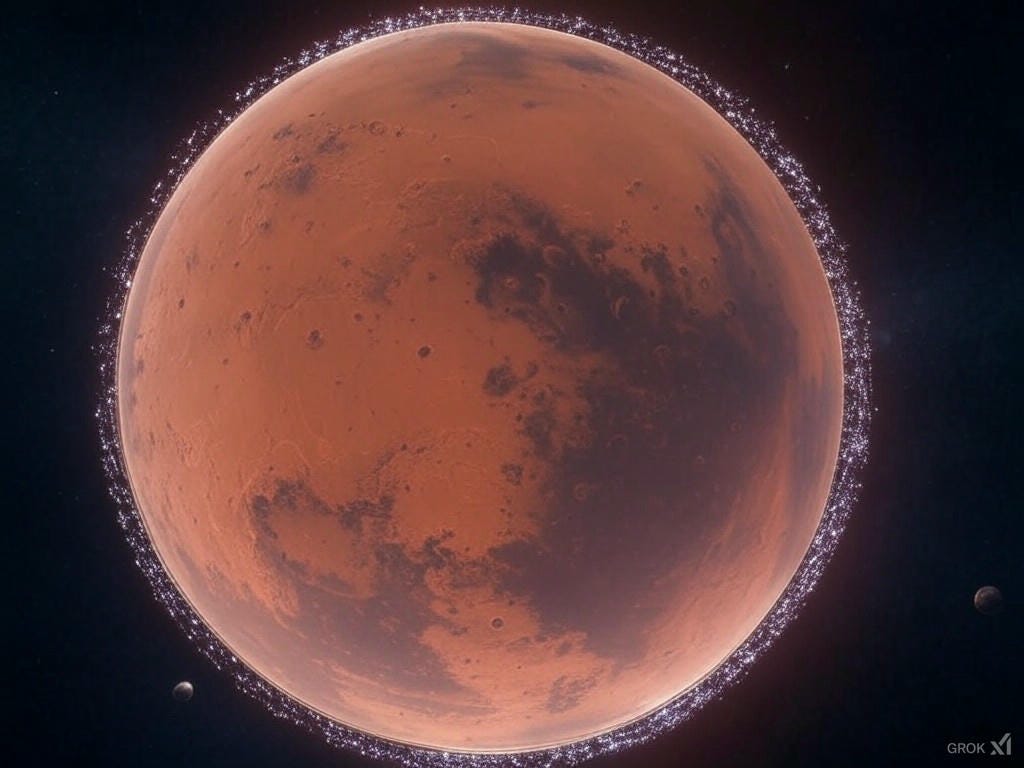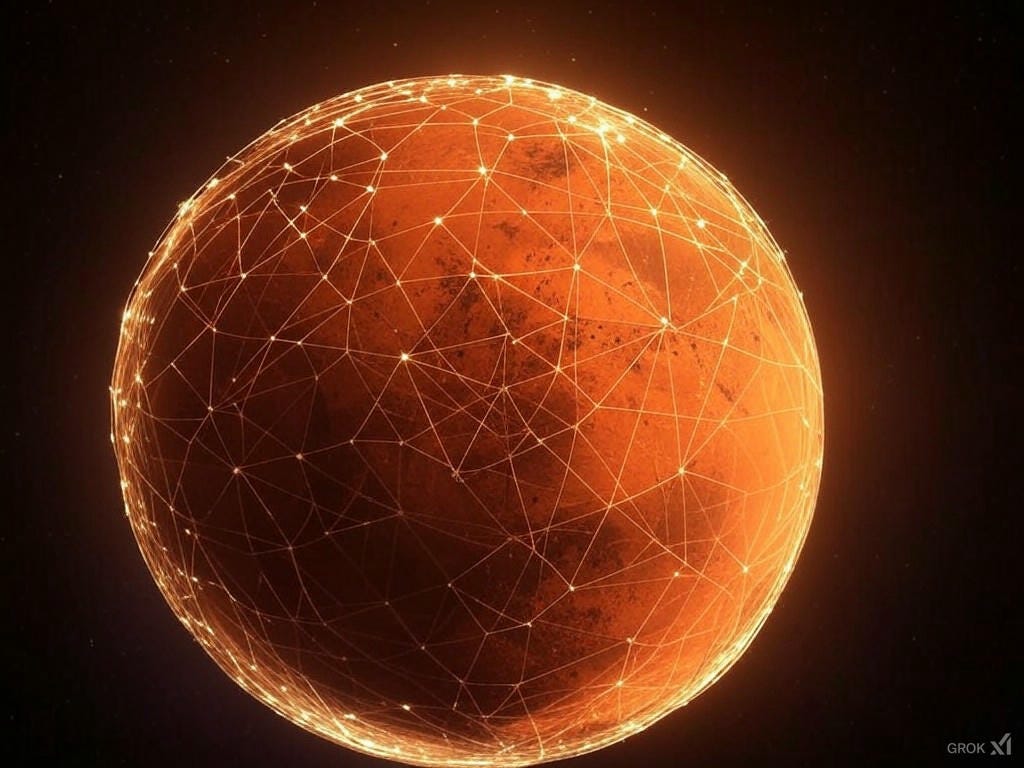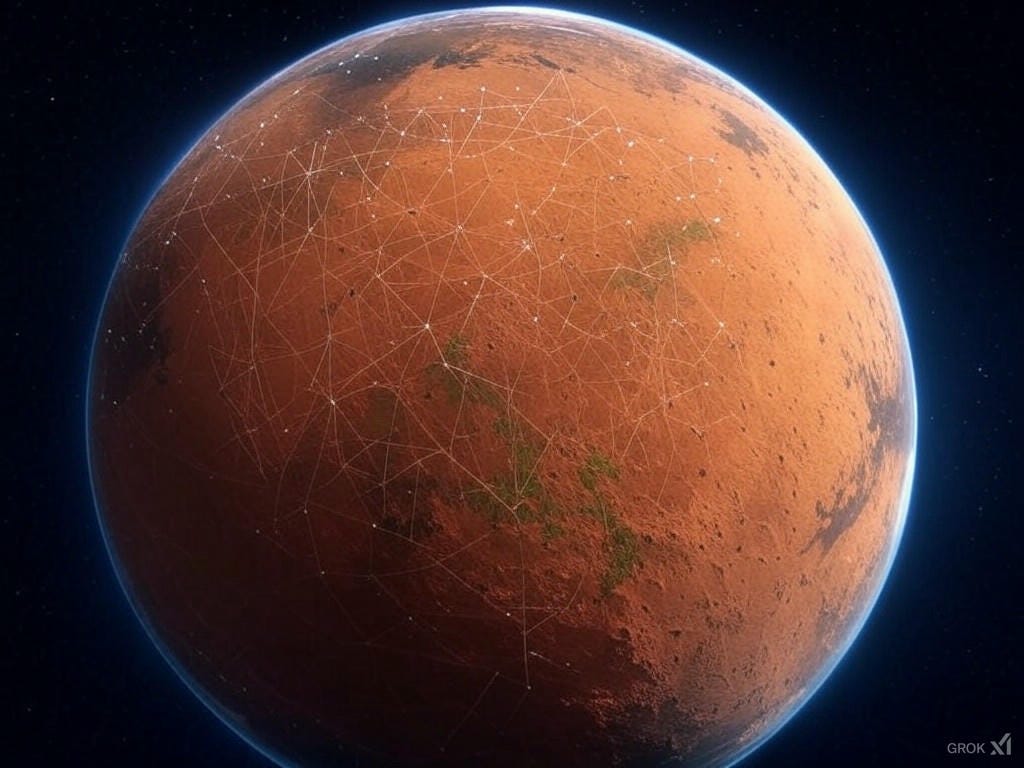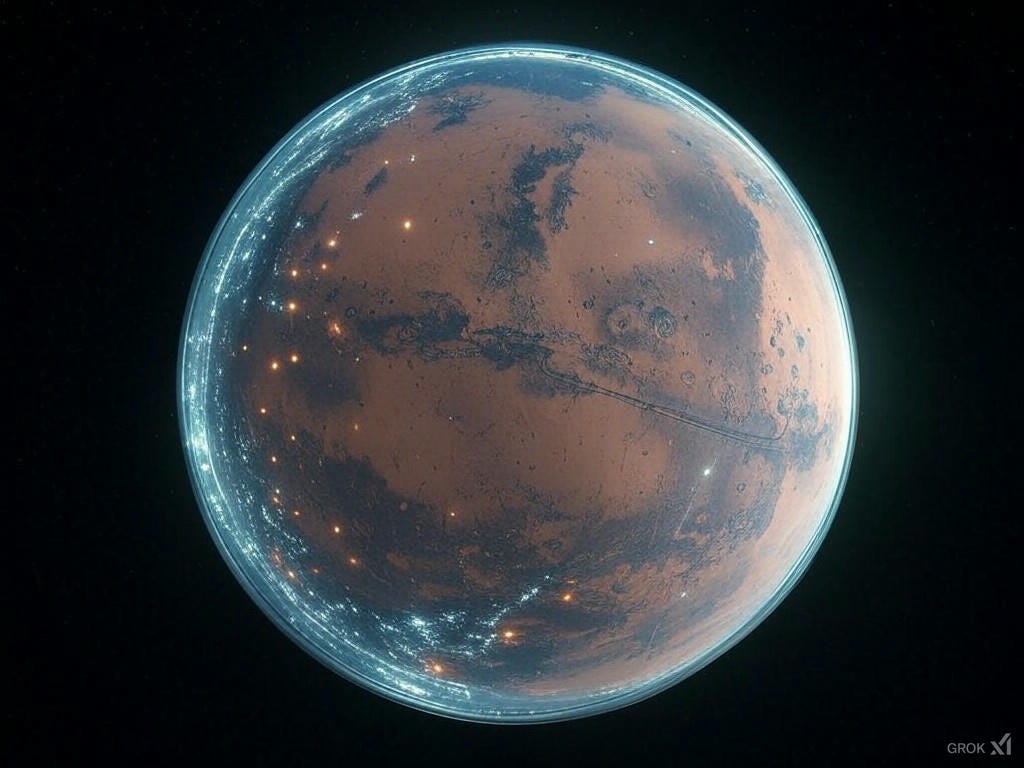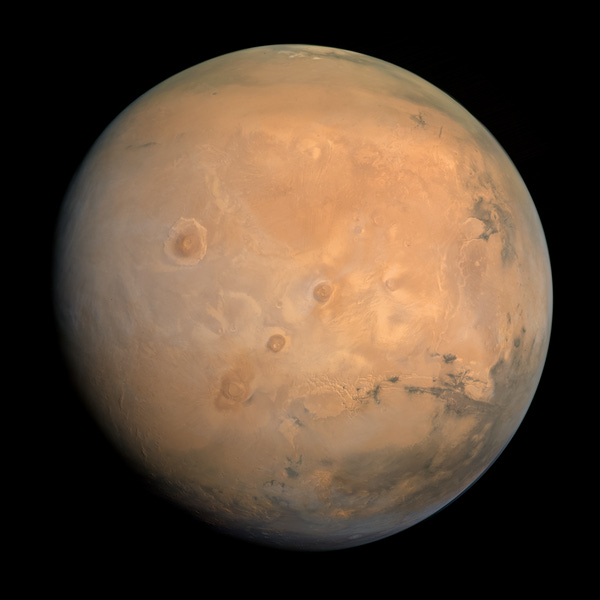Introduction
Mars, the Red Planet, has long captivated humanity's imagination as a frontier for exploration and expansion. Achieving a self-sustaining human presence on Mars requires a strategic, incremental approach, leveraging innovations in satellite technology, energy systems, and habitat construction. This project outlines a transformative roadmap to terraform Mars, with a protective atmospheric shield, advanced ISRU (In-Situ Resource Utilization), and interplanetary synergy anchored by lunar advancements. It integrates ongoing efforts by leading companies and agencies already developing technologies to achieve these goals.
1. Incremental Progress: The Moon as the Stepping Stone
The Artemis campaign and its Moon-to-Mars architecture offer critical insights into building resilient infrastructure for Mars:
Lunar Refueling Stations: NASA’s Artemis program and partnerships with SpaceX and Blue Origin are advancing hydrogen and oxygen extraction technologies to provide essential fuel for Mars-bound missions.
Testing ISRU and Robotics: Companies like Astrobotic and Intuitive Machines, under NASA’s Commercial Lunar Payload Services (CLPS) program, are developing robotic systems to test resource extraction and in-situ manufacturing on the Moon, vital precursors for Martian settlement.
Habitat Construction: Expandable habitats like Bigelow Aerospace’s inflatable modules and Sierra Space’s Orbital Reef prototypes ensure scalable solutions for lunar and Martian habitats.
SpaceX’s Starship: Designed for interplanetary travel, Starship plays a crucial role in transporting cargo and crew to the Moon and Mars, setting the stage for long-term colonization.
2. Terraforming Mars: Engineering a New World
Atmospheric Shield
One of Mars’ critical vulnerabilities is its thin atmosphere. A magnetic shield stationed at Mars’ L1 Lagrange point could mitigate solar wind stripping, enabling the gradual buildup of CO2 and other gases. Leveraging SpaceX’s advanced manufacturing capabilities and Starlink’s satellite grid framework, a network of autonomous, AI-enhanced satellites could form the backbone of this shield. These satellites, designed to create a cohesive magnetic field, would operate using xAI’s real-time adaptive algorithms to maintain optimal configurations and counteract solar wind effects. Each satellite would be powered by Tesla’s solar and battery technologies, ensuring resilience and energy efficiency in the harsh Martian environment. The integration of these technologies marks a significant step in creating a sustainable atmospheric shield, paving the way for Mars’ terraforming and eventual habitability.
Autonomous Satellite Grids: SpaceX’s Starlink-inspired networks could deploy and maintain shield systems, leveraging advanced AI algorithms developed by xAI to monitor and adapt grid configurations.
Energy Requirements: Tesla’s solar arrays and NASA’s nuclear fission systems provide the necessary power to sustain shield operations.
Climate Engineering
Terraforming Mars involves transforming its climate through controlled greenhouse gas release and microbial engineering:
CO2 Liberation: ISRU systems, such as those developed by NASA’s MOXIE experiment on the Perseverance rover, can scale up to extract and release subsurface CO2 using heat and chemical reactions.
Bioengineered Microbes: Partnerships with biotech companies aim to engineer microorganisms capable of enhancing soil quality and preparing it for plant life.
ISRU Expansion
Martian resource utilization forms the backbone of long-term settlement:
Water Extraction: Mining ice deposits, as explored by missions like ESA’s ExoMars and NASA’s Mars Ice Mapper, will support life support systems and fuel production.
Material Production: Using regolith for 3D-printed habitats and shielding, a technology championed by ICON and NASA’s lunar and Martian construction initiatives.
3. Building a Sustainable Martian Economy
Energy Independence
Mars settlements demand robust, scalable power solutions:
Nuclear Fission: NASA’s Kilopower project and DARPA’s DRACO nuclear thermal propulsion research are laying the groundwork for small modular reactors that provide uninterrupted energy for habitats and ISRU facilities.
Solar Arrays with AI Management: Dynamic systems developed by Tesla and NASA adapt to Martian dust storms and reduced solar flux, ensuring energy storage and distribution.
Satellite Communication Networks
A global satellite array enables essential communication and navigation for settlers:
Martian GPS Systems: Leveraging interconnected satellite nodes to map the surface and guide exploration vehicles.
Data Transfer to Earth: SpaceX’s Starlink infrastructure ensures real-time scientific data relay and operational updates.
Self-Repairing Infrastructure
Tesla’s Optimus robots, guided by xAI, perform autonomous repairs and upgrades:
Maintenance of Habitat Systems: Ensuring airlocks, life support, and thermal regulation systems operate without human intervention.
Mobility Integration: Robotics-enabled logistics for transporting cargo from landing sites to operational zones.
4. Synergies Between the Moon and Mars
Lunar Testbeds for Martian Technology
Advancements on the Moon directly benefit Mars exploration:
Energy Systems: Demonstrating fission power scalability during Artemis missions through partnerships with BWXT and Aerojet Rocketdyne.
Surface Mobility: NASA’s Lunar Terrain Vehicle (LTV) and partnerships with companies like Lockheed Martin develop vehicles for cargo transport under regolith and gravity constraints.
Dust Mitigation: Creating solutions for regolith contamination, informed by lunar exploration, applicable to both worlds.
Resource Hubs
The Moon’s proximity enables efficient resource caching for Mars-bound missions:
Fuel Staging Points: Hydrogen extracted on the Moon powers interplanetary transfers, supported by SpaceX’s refueling infrastructure.
Manufacturing Nodes: Orbital factories on the Moon supply components for Mars colonization, a vision supported by Orbital Reef and Voyager Space.
5. The Long-Term Vision
Expanding Terraforming Efforts
Once the basic atmospheric shield and resource systems are established, further advancements include:
Hydroponics and Agriculture: Scaling food production to support large settlements, with contributions from companies like Plenty and SpaceX’s research initiatives.
Terraforming Machines: Deploying autonomous systems to accelerate atmospheric and geological changes, supported by international collaboration with ESA and JAXA.
Interplanetary Trade Networks
Mars can serve as a hub for future missions to the asteroid belt and beyond, creating a sustainable economic ecosystem.
To The… Mars
Terraforming Mars and establishing a human presence requires unprecedented collaboration, innovation, and vision. Companies such as SpaceX, Tesla, Sierra Space, Bigelow Aerospace, Voyager Space, Blue Origin, and biotech leaders are spearheading this generational mission. Incremental progression through lunar advancements—fueled by NASA's Artemis program, SpaceX's Starship, and Orbital Reef—provides a foundation for Mars colonization. Initiatives like NASA's Kilopower project, DARPA's DRACO research, ICON's 3D printing technologies, and Tesla's Optimus robotics demonstrate the technological synergy driving this effort. By integrating these innovations, humanity can transform the Red Planet into a thriving second home, ensuring the survival and prosperity of life beyond Earth.



